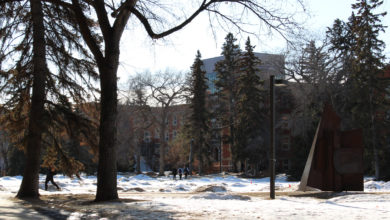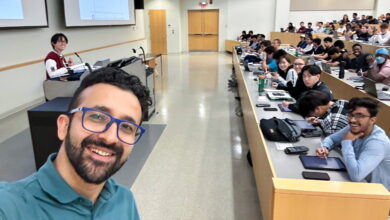 Abbeygael Kuchmak
Abbeygael KuchmakA group of six professors have published a collection of their work on the corporatization of higher education in The Contest Future of Higher Education: Lessons from Alberta. The works were first published in the Review of Education, Pedagogy, and Cultural Studies.
The collection focused on the developments at the University of Alberta after 2019, when the United Conservative Party government cut funding to post-secondary institutions (PSIs) across Alberta. In the summer of 2021, the U of A then launched a new college model as part of its academic restructuring.
The Gateway spoke to Laurie Adkin, a professor emerita of political science at the U of A, who wrote the introduction and edited the book.
Adkin explained that she defines the corporatization of higher education as the transformation of governance at PSIs.
“They have been transformed to have a style of management which is more like the executive management of a corporation,” she said.
Adkin also explained that the shift in management style brings a shift in priorities and attitudes of leaders.
“[The university] has clients, it offers services, it offers products and commodities, and it tries to increase revenue and manage its budget and so it operates very much within this framework of its financial and budgetary rules. And what tends to get sidelined in this mentality is that the public university was never meant to be a profit-making or revenue generating organization.”
Adkin said that the change in the governance structure has pushed faculty out of the decision making process when it comes to the U of A’s priorities and future direction.
Degrees and research have been commodified, according to Adkin
She said that funding cuts by conservative governments starting back in the 1990s have largely driven the corporatization of higher education in Alberta.
“They cut the operating grants to universities. That means the universities have to replace that revenue somehow,” Adkin said.
Adkin explained that the main way PSIs have replaced that revenue is through increasing tuition fees. Additionally, the U of A has begun investing in real estate to try to generate revenue, according to Adkin.
She said that there was an expansion of public universities and an increase in demand for higher education after World War II. For a couple of decades, working class people were able to live at home, attend university full-time, and didn’t pay high tuition.
“It’s been a long time since that was a reality for most students,” Adkin said.
Now students have to work through university, borrow money, go into debt, and try to finish their degree as quickly as possible in order to enter the workforce and pay off those debts, according to Adkin.
She said she has seen this affect the quality of education students receive. By taking a full course load to be able to finish their degree as quickly as possible, they don’t get a full experience, according to Adkin.
“They’re actually not learning or they’re getting a fraction of what they’re paying for in terms of what they could get out of those courses,” Adkin said. “If they took fewer courses and they slowed everything down, they would be learning so much more, and they’d be under so much less stress.”
Adkin said when she asked students about this, they would say that they couldn’t afford to take longer in their degree.
Emphasis on class sizes after academic restructuring
In her research, Adkin found that the ratio of students to faculty has increased. Class sizes have increased and faculty have faced pressure to stop teaching the smaller classes which are seen as uneconomical, according to Adkin.
She said that the U of A brought in a threshold of 12 students for fourth-year courses. For graduate level courses the threshold is six students. If the threshold is not met, the U of A would not offer the course.
Adkin said that in certain departments, there are rarely 12 or more students in a fourth-year course.
“There goes, right away, in some of the smaller departments or faculties, almost your whole program.”
She described it as the university writing off that knowledge.
“People spend years of their lives building up and developing new academic programs. And then with the funding cut, they just erased it.”
Failure in university and student leadership at the U of A
Adkin explained that the conversation around university education needs to change. She said that the government talks about universities within a framework of technical and vocational education. The conversation should be about post-secondary education as a continuation of public education, Adkin said.
She also said university leadership needs to focus on building public support for universities.
“That’s, I think, where these leaders are really failing,” Adkin said.
Adkin emphasized the need to demonstrate to communities what universities can do for them through teaching and research.
“We can develop different kinds of bridges and different kinds of relationships to our communities that really embed us in those communities so people understand what we do for them.”
“That would mean that the university will kind of reorient itself towards the service and public interest mission,” Adkin said.
She added that she thinks a lot of academics yearn for “that sense [that] what they’re doing matters and it’s connected to communities and social movements outside the university.”
Adkin said she had tried to get multiple student leaders to write a chapter in the book, but “for various reasons they didn’t.”
“The student’s perspective on this is critical,” she said. “We will not get anywhere because it’s only when students get mobilized that things happen.”
She said that students need to understand the governance structure of the U of A and the bigger picture of what is happening to higher education.
“It’s a huge problem that we don’t have student leadership that is better informed and more political and progressive around what’s happening.”




